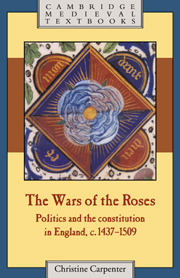Book contents
- Frontmatter
- Contents
- List of illustrations
- Preface
- Introduction
- 1 Sources and historiography
- 2 The governance of England in the fifteenth century I: kings, kingship and political society
- 3 The governance of England in the fifteenth century II: nobility, gentry and local governance
- 4 The Lancastrian kings to c. 1437
- 5 Henry VI's adult rule: the first phase c. 1437–1450
- 6 The road to war: 1450–145
- 7 The end of Lancastrian rule: 1455–1461
- 8 Edward IV's first reign: 1461–1471
- 9 The triumph of York: 1471–1483
- 10 Richard III and the end of Yorkist rule: 1483–1485
- 11 Henry VII and the end of the wars: 1485–1509
- 12 Conclusions
- Bibliographical notes
- Index
- Cambridge Medieval Textbooks
10 - Richard III and the end of Yorkist rule: 1483–1485
Published online by Cambridge University Press: 05 June 2012
- Frontmatter
- Contents
- List of illustrations
- Preface
- Introduction
- 1 Sources and historiography
- 2 The governance of England in the fifteenth century I: kings, kingship and political society
- 3 The governance of England in the fifteenth century II: nobility, gentry and local governance
- 4 The Lancastrian kings to c. 1437
- 5 Henry VI's adult rule: the first phase c. 1437–1450
- 6 The road to war: 1450–145
- 7 The end of Lancastrian rule: 1455–1461
- 8 Edward IV's first reign: 1461–1471
- 9 The triumph of York: 1471–1483
- 10 Richard III and the end of Yorkist rule: 1483–1485
- 11 Henry VII and the end of the wars: 1485–1509
- 12 Conclusions
- Bibliographical notes
- Index
- Cambridge Medieval Textbooks
Summary
Edward IV died suddenly on 9 April. Although his death was unexpected, he lingered for ten days and recovered sufficiently after the first attack to make provision for his son's minority. Unfortunately we do not know what this was; the only source, Mancini, on whose version much of the conventional account of the usurpation is based, was written by a foreigner who did not know English and, not having access to the seat of power, had to rely on hearsay from those with whom he could converse. He also wrote after the event, and he is the writer most responsible for the hindsight which has made discussion of the last years of Edward IV and of the deposition of his son so difficult. Mancini alleges bad feeling between Gloucester and the Woodvilles, which led to Edward's wishes that his brother act as Protector being overturned by the queen and her family. There is on the contrary no evidence of tension before Edward IV s death and the author of the Croyland Continuation, the other main narrative source for the reign, who was very close to the centre of affairs, implies that Edward's will, whatever it was, was carried out. Indeed, it has recently been suggested that Edward intended his son to stay with the Woodvilles, and it would have been logical to leave the boy with his family while he was still a minor.
- Type
- Chapter
- Information
- The Wars of the RosesPolitics and the Constitution in England, c.1437–1509, pp. 206 - 218Publisher: Cambridge University PressPrint publication year: 1997



